
Genus Sciurus

The Genus Sciurus includes many of the most common, bushy-tailed squirrels in North America, South America, Europe and northern Asia. Most of the urban squirrels seen in many of the cities of the world are within this genus.
The following species have galleries of images below:
Kaibab squirrel (Sciurus aberti kaibabensis)
Abert’s Squirrel (Sciurus aberti aberti)
Arizona Gray Squirrel (Sciurus arizonensis)
Eastern Gray Squirrel (Sciurus carolinensis)
Western Gray Squirrel (Sciurus griseus)
Japanese Squirrel (Sciurus lis)
Apache (Mexican) Fox Squirrel (Sciurus nayaritensis)
Eastern Fox Squirrel (Sciurus niger)
European Red Squirrel (Sciurus vulgaris)
Kaibab squirrel (Sciurus aberti kaibabensis)
The Kaibab squirrel (Sciurus aberti kaibabensis) is a tassel-eared squirrel that lives in the Kaibab Plateau in the Southwest United States, in an area of 20 by 40 miles (32 by 64 km). The squirrel's habitat is confined entirely to the ponderosa pine forests of the North Rim of Grand Canyon National Park and the northern section of Kaibab National Forest around the town of Jacob Lake, Arizona.
This squirrel is not found anywhere else in the world. In 1965, 200,000 acres (810 km2) of Kaibab squirrel habitat within Grand Canyon National Park and Kaibab National Forest were declared the Kaibab Squirrel National Natural Landmark.
Kaibab squirrels usually have a black belly (which is sometimes gray), white tail, tufted ears and chestnut brown head. The tufts on the ears grow longer with age and may extend 1 to 2 inches (2.5 to 5.1 cm) above the ears in the winter, and may not be visible in the summer.
The Kaibab squirrel lives in ponderosa pine forests, where it builds its nest out of twigs and pine needles. Kaibab squirrels, ponderosa pines, and the fungi which grow in the vicinity of the ponderosas exist in a symbiotic relationship. The squirrel eats acorns, fruit, and fungi (especially an underground truffle), as well as the seeds, bark, and twigs of the trees where it makes its home. The Kaibab squirrel's most significant source of food is the seeds found within ponderosa pine cones. Young squirrels are born between April and August.
In the past the Kaibab squirrel was given species status (Sciurus kaibabensis) but today is considered a subspecies of the Abert's squirrel, (Sciurus aberti).
The Kaibab squirrel is an example of evolution occurring through geographic isolation, but not because of the canyon. Compared to the Kaibab squirrel, the Abert's squirrel, with its several subspecies, has a much broader distribution and is found on the South Rim of the Grand Canyon. The difference between North Rim and South Rim Abert's squirrels has given rise to the commonly held but incorrect assumption that the canyon itself acted as a barrier preventing gene flow between the two populations. However, modern Kaibab squirrels are descended from populations of Abert's squirrels that dispersed into the Grand Canyon area following the last Ice Age.
As the climate warmed, ponderosa pine stands and the Abert's squirrels living there were limited to areas of high elevation like the Kaibab Plateau. These isolated populations eventually became modern Kaibab squirrels and, as the climate cooled again and ponderosa pines once again grew at lower elevations, other Abert's squirrel subspecies returned to the Grand Canyon area, filling in their former niches on the South Rim.
Kaibab Squirrel (Sciurus aberti kaibabensis) - Jacob Lake, Arizona North Rim subspecies















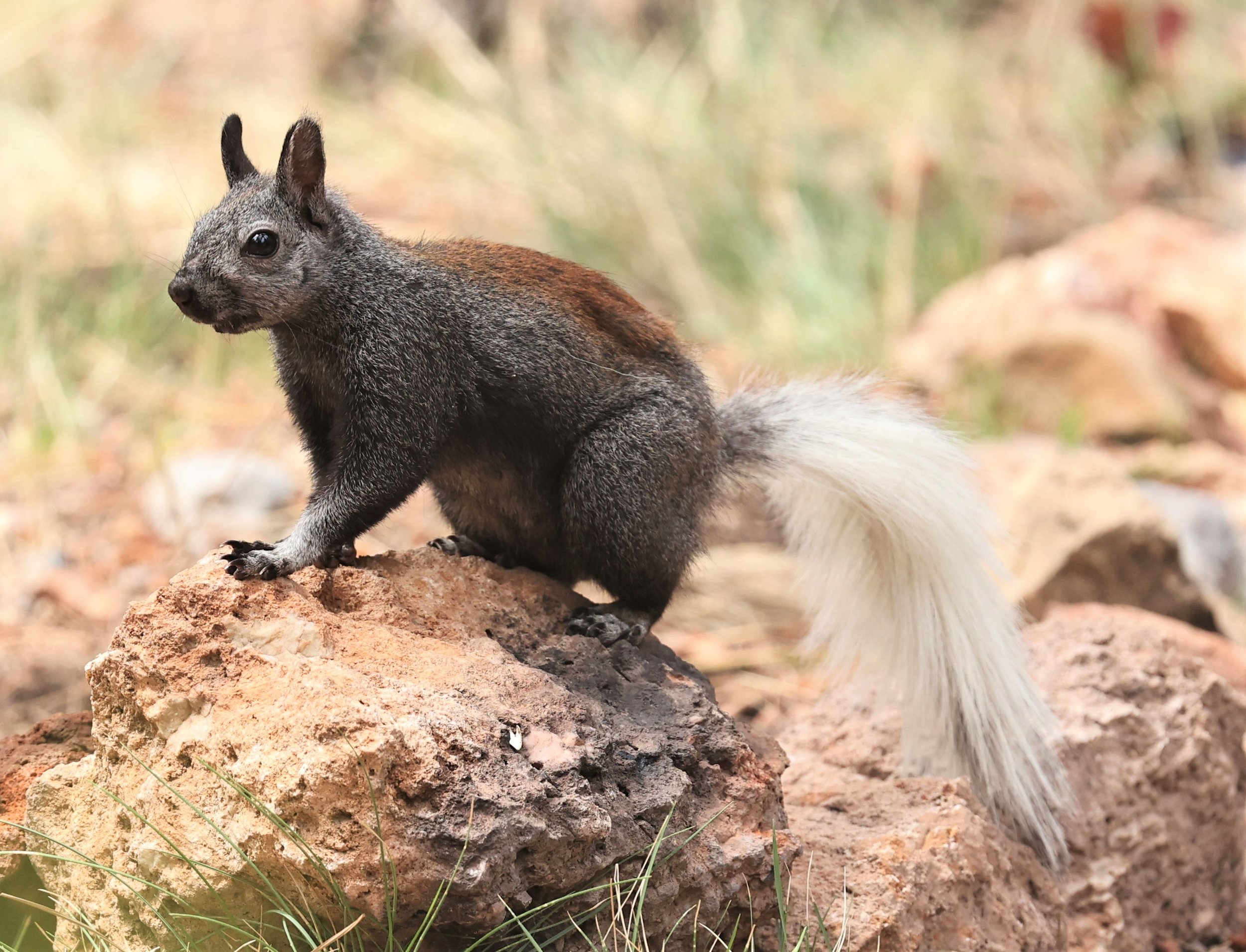


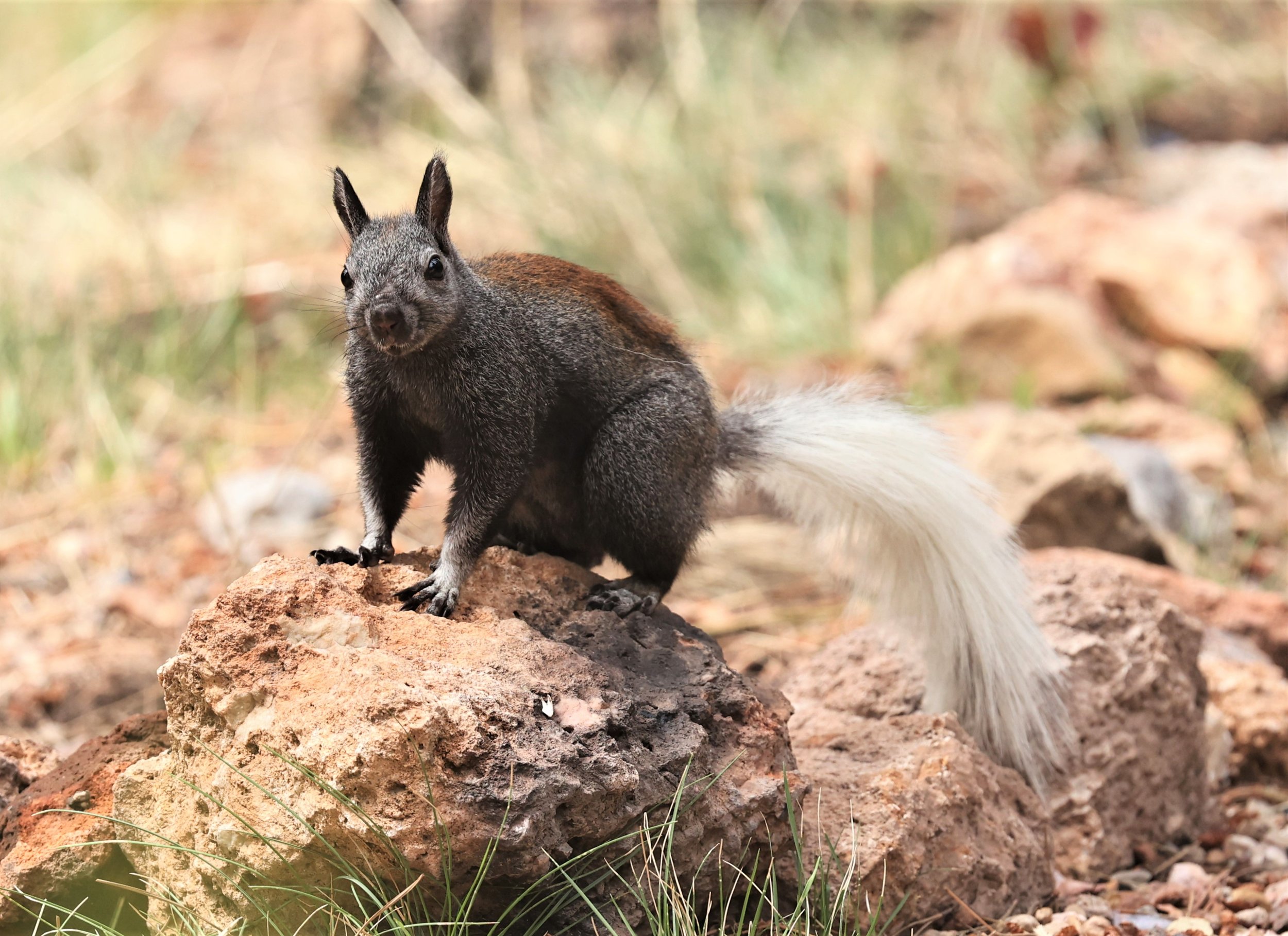













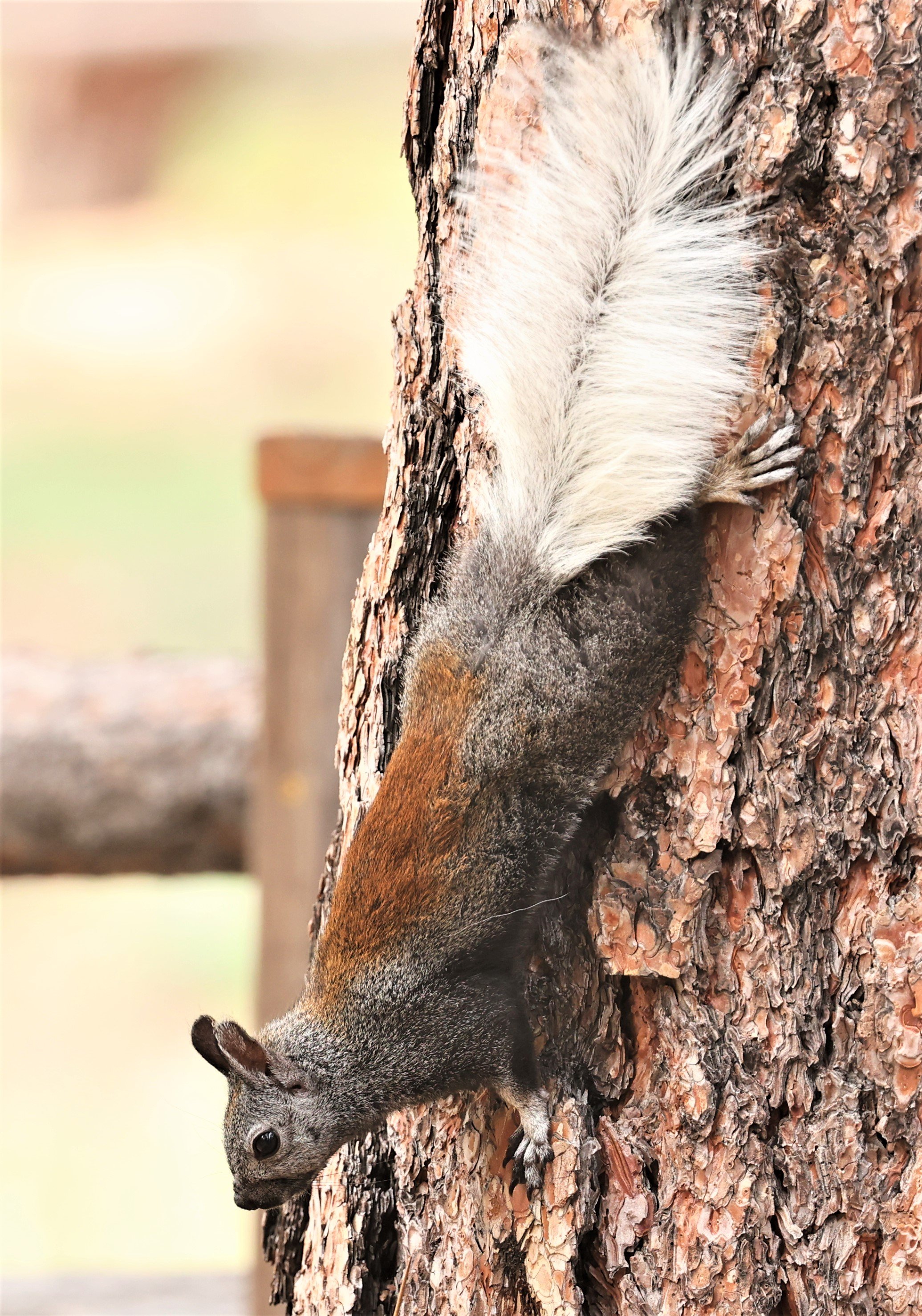



















































Abert's Squirrel or the Tassel-eared Squirrel (Sciurus aberti)
Abert's squirrel or the tassel-eared squirrel (Sciurus aberti) is a tree squirrel in the genus Sciurus native to the southern Rocky Mountains from the United States to the northern Sierra Madre Occidental of Mexico, with concentrations found in Arizona, New Mexico, and southwestern Colorado. It is closely associated with, and largely confined to, mature ponderosa pine forests. It is named in honor of the American naturalist John James Abert; nine subspecies are recognised. It is recognizable by its tufted ears, gray color, pale underparts and rufous patch on the lower back. The squirrel feeds on the seeds and cones of the Mexican pinyon and the ponderosa pine when they are available, but will also take fungi, buds, bark, and carrion. Breeding normally occurs in summer, with a spherical nest being built high in the canopy.
Abert's squirrel is named after Colonel John James Abert, an American naturalist and military officer who headed the Corps of Topographical Engineers and organized the effort to map the American West in the 19th century.
The currently accepted scientific name for Abert's squirrel is Sciurus aberti Woodhouse. There are nine recognized subspecies, including the Kaibab squirrel (S. a. kaibabensis), formerly recognized as a separate species (S. kaibabensis). The nine subspecies are listed in the Distribution section.
Abert's squirrels are 46–58 cm long with a tail of 19–25 cm. The most noticeable characteristic would be their hair ear tufts, which extend up from each ear 2–3 cm. This gives this species a striking similarity to the Eurasian red squirrel, aside from its differing dark coloration. They typically have a gray coat with a white underbelly and a very noticeable rusty/reddish colored strip down their back. Abert's squirrels found in Colorado rocky mountain foothills appear black all over as shown in the adjacent image.
Abert's squirrel is confined to the Colorado Plateau and the southern Rocky Mountains of Colorado, Utah, Arizona, and New Mexico; its range extends south in the Sierra Madre Occidental to Chihuahua and Durango in Mexico. Abert's squirrel also extends a short distance into Wyoming where ponderosa pine (Pinus ponderosa) is present.[citation needed] Abert's squirrels transplanted to the Graham and Santa Catalina Mountains of Arizona have established stable populations.[citation needed] Mellott and Choate reported Abert's squirrels present in the Spanish Peaks State Wildlife Area, 43 miles (69 km) southeast of the previously known Abert's squirrel range.
The distribution of Abert's squirrel subspecies in the Southwest is coincident with the disjunct ponderosa pine forests. Subspecies distributions are as follows:
S. a. aberti (Woodhouse) – northern Arizona
S. a. barberi (Allen) – northwestern Chihuahua
S. a. chuscensis (Goldman) – New Mexico-Arizona border area
S. a. durangi (Thomas) – Durango
S. a. ferreus (True) – Rocky Mountains, central Colorado
S. a. kaibabensis – Kaibab Plateau, northern Arizona
S. a. mimus (Merriam) – New Mexico-Colorado border area
S. a. navajo (Durrant and Kelson) – southeastern Utah
S. a. phaeurus (Allen) – northwestern and southwestern Durango and southwesternmost Chihuahua
Abert's squirrels in the US make almost exclusive use of ponderosa pine for cover, nesting, and food. In Mexico where ponderosa pines are absent, the species is found in stands of the closely related Pinus arizonica. Optimum Abert's squirrel habitat is composed of all-aged ponderosa pine stands with trees in even-aged groups, densities of 168 to 250 trees per acre (496–618/ha), and 150 to 200 square feet per acre (34.4–45.3 sq m/ha) basal area. In optimum habitat average diameter of ponderosa pines is 11 to 13 inches (28 to 33 centimetres), with Gambel oaks in the 11.8- to 14-inch (30–36 cm) diameter at breast height (d.b.h.) range. Optimum habitat has some ponderosa pine over 20 inches (51 cm) d.b.h., which are the best cone producers. Larson and Schubert report that ponderosa pine 36 to 40 inches (91 to 102 centimetres) d.b.h. produced an average of 446 cones per tree per crop. Trees less than 24 inches (61 cm) d.b.h. produced fewer than 100 cones per crop.
In central Arizona, Abert's squirrel summer home ranges averaged 18 acres (7.3 hectares) and ranged from 10 to 24 acres (4.0 to 9.7 ha). Ranges were somewhat smaller in winter. Ramey reports that the mean Abert's squirrel home range for spring and summer was 20 acres (8.1 hectares) in Black Forest, Colorado. Subadult males had spring home ranges of about 27 acres (11 hectares), and adult females had somewhat larger summer home ranges than adult males. Patton reported the ranges of three squirrels as 10, 30, and 60 acres (4.0, 12.2, and 24.4 ha) in Arizona. Hall reported the home range of an adult female as 29 acres (12 hectares).
In Colorado, Ramey found a density of 83 squirrels per square mile (30/km2) in spring 1970 but only 33 squirrels per square mile (12/km2) in spring 1971. In another Colorado study, Farentinos estimated 227 squirrels per square mile (82/km2) in fall 1970 and 317 per square mile (114/km2) in fall 1971.
Abert’s Squirrel (Sciurus aberti aberti) - South Rim region of the Grand Canyon in Northern Arizona



































Arizona Gray Squirrel (Sciurus arizonensis)
The Arizona gray squirrel (Sciurus arizonensis) is a tree squirrel, in the genus Sciurus, endemic to the canyons and valleys surrounded by deciduous and mixed forests in eastern Arizona and northern Mexico.
It is threatened by habitat loss. The only other large squirrel that is within its range is Abert's squirrel, which has ear tufts and lives in pine forests. Although they act and look like other gray squirrels, the Arizona gray squirrel is actually more closely related to the fox squirrel.
Sciurus arizonensis is a member of the order Rodentia and the family Sciuridae. It is distinguishable from Sciurus aberti by its longer flatter skull, broader rostrum, and having only one molar instead of two. S. arizonensis also has smaller ears with no tufts and a red/black stripe on the underside of their tail. Some sexual dimorphism can be seen in these squirrels, but it varies with some populations having larger males, and other populations having larger females.
Sciurus arizonensis or the Arizona gray squirrel can be found in parts of Arizona, New Mexico and Sonora, Mexico. They live in the mountains at mid-elevations in riparian habitats, usually broadleaf riparian habitats. The Arizona gray squirrel has had no recent expansion or reduction in the size of their range in New Mexico, though there has been some population decline. This is due to habitat loss and the introduction of Abert’s squirrel, which has in some cases outcompeted the Arizona gray squirrel for resources.
Arizona Gray Squirrel (Sciurus arizonensis) - Southeast Arizona in multiple locations






















Eastern Gray Squirrel (Sciurus carolinensis)
The eastern gray squirrel (Sciurus carolinensis), also known, particularly outside of North America, as simply the grey squirrel, is a tree squirrel in the genus Sciurus. It is native to eastern North America, where it is the most prodigious and ecologically essential natural forest regenerator. Widely introduced to certain places around the world, the eastern gray squirrel in Europe, in particular, is regarded as an invasive species.
In Europe, Sciurus carolinensis is included since 2016 in the list of Invasive Alien Species of Union concern (the Union list). This implies that this species cannot be imported, bred, transported, commercialized, or intentionally released into the environment in the whole of the European Union.
Sciurus carolinensis is native to the eastern and midwestern United States, and to the southerly portions of the central provinces of Canada. The native range of the eastern gray squirrel overlaps with that of the fox squirrel (Sciurus niger), with which it is sometimes confused, although the core of the fox squirrel's range is slightly more to the west. The eastern gray squirrel is found from New Brunswick, through southwestern Quebec and throughout southern Ontario plus in southern Manitoba, south to East Texas and Florida. Breeding eastern gray squirrels are found in Nova Scotia, but whether this population was introduced or came from natural range expansion is not known.
A prolific and adaptable species, the eastern gray squirrel has also been introduced to, and thrives in, several regions of the western United States and in 1966, this squirrel was introduced into Vancouver Island in Western Canada in the area of Metchosin, and has spread widely from there. They are considered highly invasive and a threat to both the local ecosystem and the native squirrel, the American red squirrel.
Overseas, Eastern gray squirrels in Europe are a concern because they have displaced some of the native squirrels there. They have been introduced into Ireland, Britain, Italy, South Africa, and Australia (where it was extirpated by 1973).
In Ireland, the native squirrel – also colored red – the Eurasian red squirrel S. vulgaris – has been displaced in several eastern counties, though it still remains common in the south and west of the country. The gray squirrel is also an invasive species in Britain; it has spread across the country and has largely displaced the red squirrel. That such a displacement might happen in Italy is of concern, as gray squirrels might spread to other parts of mainland Europe.
Eastern Gray Squirrel (Sciurus carolinensis) in various locations both native and introduced in California & Seattle











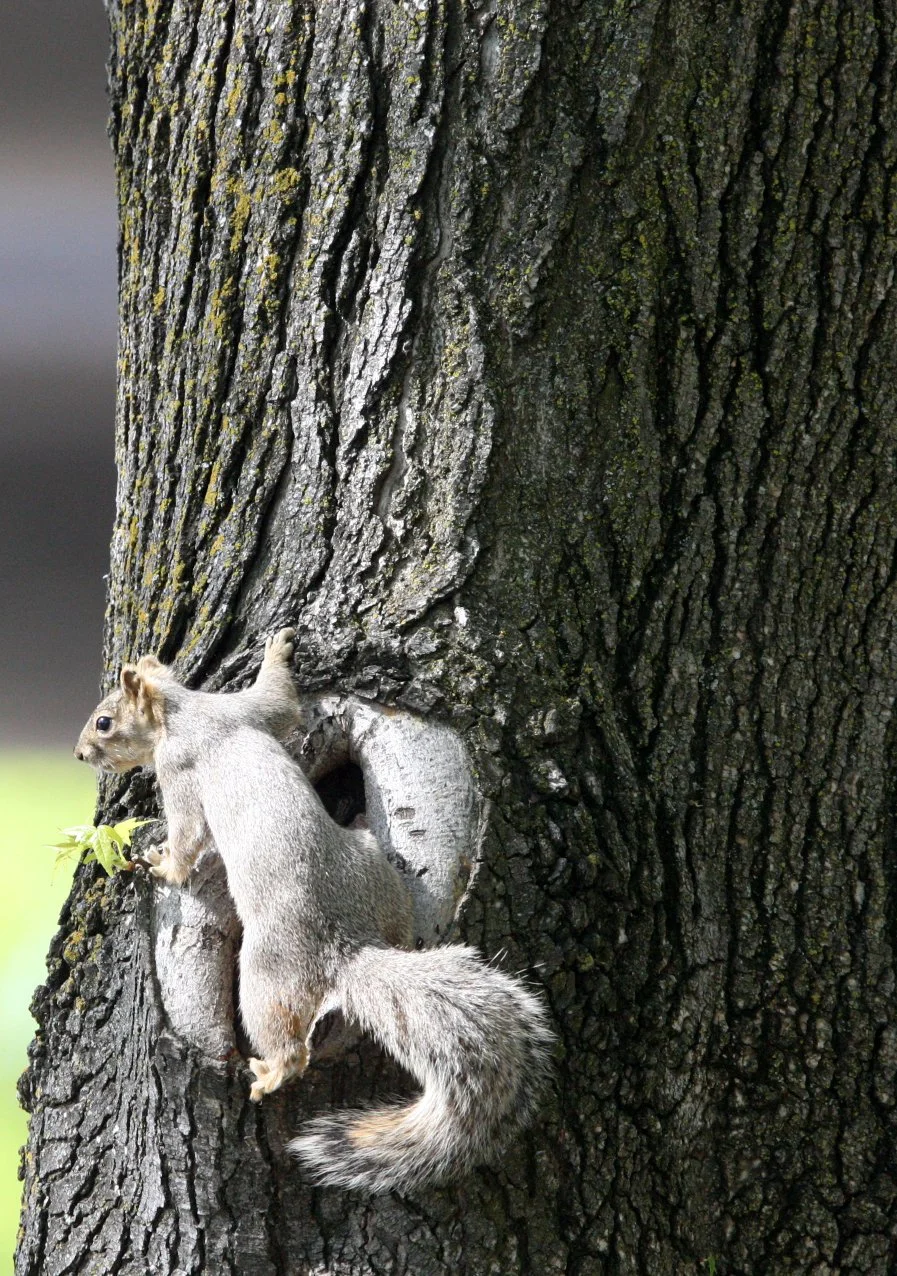













Western Gray Squirrel (Sciurus griseus)
The western gray squirrel (Sciurus griseus) is an arboreal rodent found along the western coast of the United States and Mexico. It is a tree squirrel. In some places, this species has also been known as the silver-gray squirrel, the California gray squirrel, the Oregon gray squirrel, the Columbian gray squirrel and the banner-tail. There are three geographical subspecies: Sciurus griseus griseus (central Washington to the western Sierra Nevada in central California); S. g. nigripes (from south of San Francisco Bay to San Luis Obispo County, California); and S. g. anthonyi (which ranges from San Luis Obispo to northern Baja California).
In some landscapes, the Western grey squirrel has lost habitat or experienced local extinction due to competition with other squirrel species and other pressures on their population.
Sciurus griseus is the largest tree squirrel in the Sierra Nevada and Central California range. It has plantigrade, pentadactyl feet with two phalanges.[3] Compared with the eastern gray squirrel S. carolinensis or the fox squirrel S. niger (which have been introduced into its native range), these squirrels are shy, and will generally run up a tree and give a hoarse chirping call when disturbed. Weights vary from about .35 to 1 kilogram (0.77 to 2.20 lb), and length (including tail) from 43 to 61 centimetres (17 to 24 in). It is the largest native tree squirrel in the western coastal United States. Western gray squirrels exhibit a form of coloration known as counter shading. The dorsal fur is a silver gunmetal gray, with pure white on the underside; there may be black flecks in the tail. Ears are large but without tufts. The ears turn reddish-brown at the back in the winter. The tail is long and typically very bushy. Also, it stays in a curved upwards in an "S" shape.
Tree squirrels undergo a complete head-to-tail molt in the spring and a rump-to-head molt in the fall. Tail hair is replaced only in the spring. Nesting mothers will use their tail hair to line birthing nests. Western gray squirrels eat berries, nuts, a variety of seeds, and the eggs of small birds.
Western Gray Squirrel (Sciurus griseus) - Southern California Mountains in San Jacinto & Los Padres National Forests









































Western Gray Squirrel Melanistic Form (Sciurus griseus) in Chuchapate Campgrounds area in Los Padres National Forest - very rare form










Japanese Squirrel (Sciurus lis)
The Japanese squirrel (Sciurus lis) is a tree squirrel in the genus Sciurus endemic to Japan. It was described by Dutch zoologist Coenraad Jacob Temminck in 1844. The Japanese squirrel's range includes the islands of Honshū, Shikoku, and Kyūshū. Recently, populations on south-western Honshū and Shikoku decreased, and those on Kyūshū disappeared. One of the factors affecting the local extinction of this species seems to be forest fragmentation by humans.
In certain areas, up to 35% of its diet can come from walnuts. It is possible the resulting dispersion has affected the evolution of larger seed sizes among Japanese walnut populations where Japanese squirrels are present. Furthermore, Japanese walnut (Juglans ailanthifolia) is an important food for Japanese squirrels in lowland mixed-species forests in Japan. Japanese squirrels feeding technique consists of opening the hard shell of walnuts by chewing along the crease of the shell, embedding its teeth into the cleft, and airing out the two parts. This strategy seems to be efficient since it minimizes the time to finish eating an entire walnut.
Japanese Squirrel (Sciurus lis) - from Nagano Prefecture, Japan











Mexican Fox Squirrel (Sciurus nayaritensis)
The Mexican fox squirrel (Sciurus nayaritensis) is a species of tree squirrel found throughout the Sierra Madre Occidental of Mexico as far south as Jalisco — and northward into the Chiricahua Mountains of southeastern Arizona, U.S.
This species, or its subspecies, is sometimes called the Nayarit, Apache, or Chiricahua fox squirrel. It has been evaluated as an IUCN Red List Least Concern species.
The Mexican fox squirrel has a grizzled brown back with a yellow to rufous underside, and a charcoal tail frosted with white. Two molts occur each year; the winter pelage is more rufous and the scrotum is often ringed with white. Mass is approximately 700 grams (25 oz).
Mexican fox squirrels are diurnal, non-territorial, and do not hibernate during the winter months.
The Mexican fox squirrel forages extensively on the ground and in the forest canopy for tree seeds, flowers, and fungi. Seeds from the cones from pine, Douglas-fir, and true firs are extracted by removing individual cone scales. Acorns and walnuts are also eaten when available, along with a variety of other tree seeds, hypogeous and occasionally epigeous fungi, and insects. Mexican fox squirrels occasionally cache large seeds by scatterhoarding them in leaf litter and topsoil.
The ecology of the Mexican fox squirrel has not been studied thoroughly, particularly outside the United States. Densities are often very low. Large raptors, canids, felids, procyonids and snakes are likely the major predators.
Mexican fox squirrels typically produce a single small litter of 1 or 2 young in late spring or summer. Mexican fox squirrels nest in ball-shaped dreys composed of sticks and leaves in trees; cavities within large trees are occasionally used, especially by nursing females. They are known to communally nest at times. Mexican fox squirrels are notably silent and appear to prefer to seek cover and remain motionless. If startled, they may bark and chuck from safe locations in trees.
Mexican fox squirrels are found in forests ranging from low elevation (~1,500 metres [ 4,900 ft ]) Madrean forests with a mixture of pine and oak to higher elevation mixed conifer forests < 2,700 metres [ 8,900 ft ]. Riparian areas with large cottonwoods and sycamores often harbor the highest densities. In the United States, the squirrel lives only in the Chiricahua Mountains of southeastern Arizona.
The Mexican fox squirrel inhabits forests that were historically maintained by frequent, low-severity fire, and uses areas with open understory and large trees that are typical of such forests.
There are three subspecies.
Sciurus nayaritensis nayaritensis (Nayarit fox squirrel): southern portion of the distribution range. This is a smaller and more yellowish subspecies.
Sciurus nayaritensis apache (Apache fox squirrel): northern and central portion of the distribution range. This is a subspecies intermediate in size and coloration.
Sciurus nayaritensis chiricahuae (Chiricahua fox squirrel): an endemic subspecies of the Chiricahua Mountains of southeastern Arizona (US). Characterized as more reddish throughout.
Apache (Mexican) Fox Squirrel (Sciurus nayaritensis) - Cave Creek Canyon, Arizona on South Fork Road








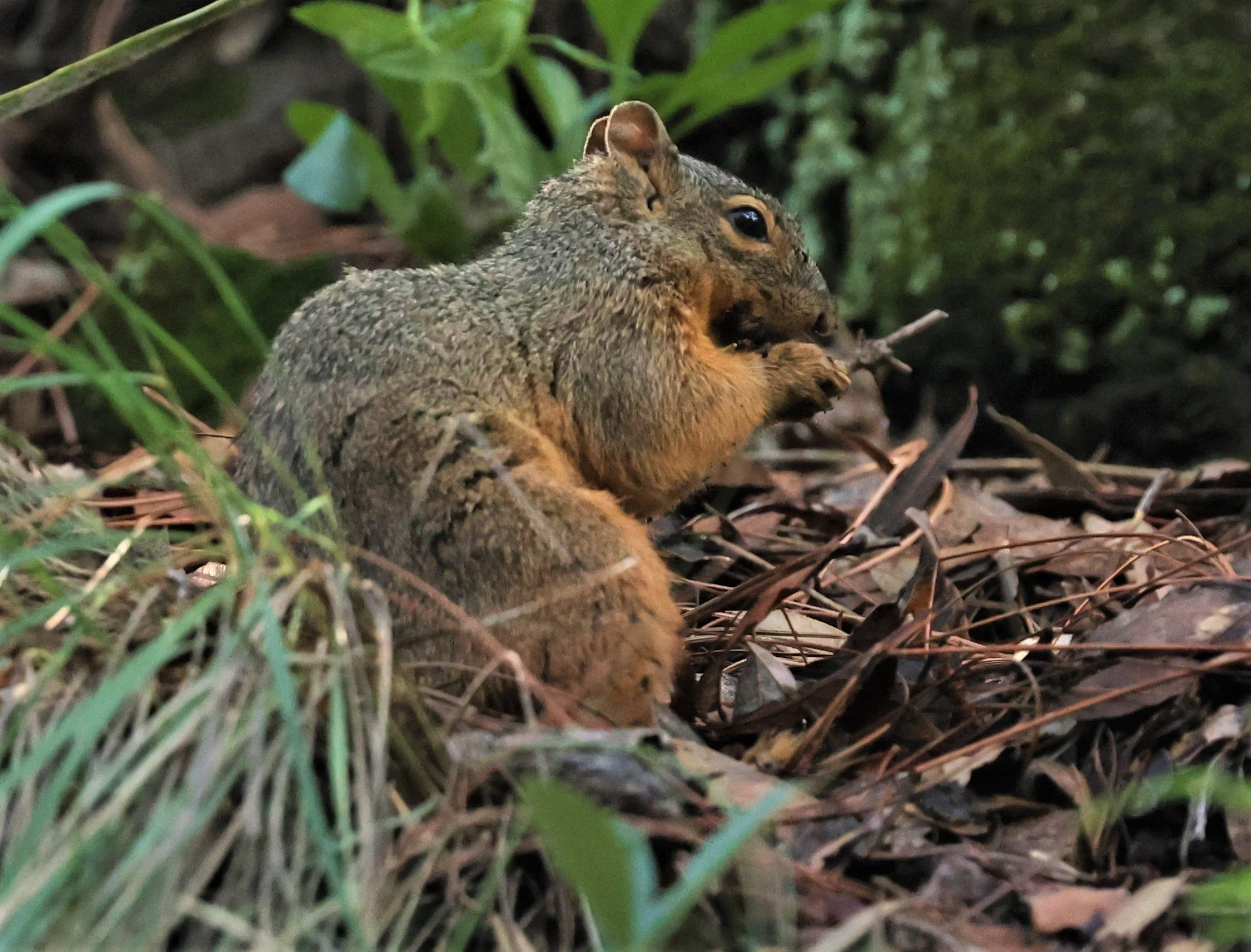




































Fox Squirrel (Sciurus niger)
The fox squirrel (Sciurus niger), also known as the eastern fox squirrel or Bryant's fox squirrel, is the largest species of tree squirrel native to North America. Despite the differences in size and coloration, it is sometimes mistaken for American red squirrels or eastern gray squirrels in areas where the species co-exist.
The squirrel's total length measures 20 to 30 in (50.8 to 76.2 cm), with a body length of 10 to 15 in (25.4 to 38.1 cm) and a similar tail length. They range in weight from 1.0 to 2.5 pounds (453.6 to 1,134.0 g). There is no sexual dimorphism in size or appearance. Individuals tend to be smaller in the west. There are three distinct geographical phases in coloration: In most areas the animal's upper body is brown-grey to brown-yellow with a typically brownish-orange underside, while in eastern regions such as the Appalachians there are more strikingly-patterned dark brown and black squirrels with white bands on the face and tail. In the south are isolated communities with uniform black coats. To help with climbing, the squirrels have sharp claws, developed extensors of digits and flexors of forearms, and abdominal musculature. Fox squirrels have excellent vision and well-developed senses of hearing and smell. They use scent marking to communicate with other fox squirrels. "Fox squirrels also have several sets of vibrissae, hairs or whiskers that are used as touch receptors to sense the environment. These are found above and below their eyes, on their chin and nose, and on each forearm." The dental formula of S. niger is 1.0.1.31.0.1.3 × 2 = 20.
The fox squirrel's natural range extends through most of the eastern United States, north into the southern prairie provinces of Canada, and west to the Dakotas, Colorado, and Texas. They are absent (except for vagrants) in New England, New Jersey, most of New York, northern and eastern Pennsylvania, Ontario, Quebec, and the Atlantic provinces of Canada. They have been introduced to both northern and southern California,[8] Oregon,[9] Idaho,[10] Montana,[10] Washington,[10] and New Mexico, as well as Ontario and British Columbia in Canada. While very versatile in their habitat choices, fox squirrels are most often found in forest patches of 40 hectares or less with an open understory, or in urban neighborhoods with trees. They thrive best among oak, hickory, walnut, pecan and pine trees, storing their nuts for winter. Western range extensions in Great Plains regions such as Kansas are associated with riverine corridors of cottonwood. A subspecies native to several eastern US states is the Delmarva fox squirrel (S. n. cinereus).
In Europe, Sciurus niger is included since 2016 in the list of Invasive Alien Species of Union concern (the Union list). This implies that this species cannot be imported, bred, transported, commercialized, or intentionally released into the environment in the whole of the European Union.
Fox squirrels are most abundant in open forest stands with little understory vegetation; they are not found in stands with dense undergrowth. Ideal habitat is small stands of large trees interspersed with agricultural land. The size and spacing of pines and oaks are among the important features of fox squirrel habitat. The actual species of pines and oaks themselves may not always be a major consideration in defining fox squirrel habitat. Fox squirrels are often observed foraging on the ground several hundred meters from the nearest woodlot. Fox squirrels also commonly occupy forest edge habitat.
Fox squirrels have two types of shelters: leaf nests (dreys) and tree dens. They may have two tree cavity homes or a tree cavity and a leaf nest. Tree dens are preferred over leaf nests during the winter and for raising young. When den trees are scarce, leaf nests are used year-round. Leaf nests are built during the summer months in forks of deciduous trees about 30 feet (9 m) above the ground. Fox squirrels use natural cavities and crotches (forked branches of a tree) as tree dens. Den trees in Ohio had an average diameter at breast height (d.b.h.) of 21 inches (53 cm) and were an average of 58.6 yards (53.6 m) from the nearest woodland border. About 88% of den trees in eastern Texas had an average d.b.h. (diameter at breast height) of 12 inches (30 cm) or more. Dens are usually 6 inches (15 cm) wide and 14–16 inches (36–41 cm) inches deep. Den openings are generally circular and about 2.9 to 3.7 inches (7.4 to 9.4 cm). Fox squirrels may make their own den in a hollow tree by cutting through the interior; however, they generally use natural cavities or cavities created by northern flickers (Colaptes auratus) or red-headed woodpeckers (Melanerpes erythrocephalus). Crow nests have also been used by fox squirrels.
Fox squirrels use leaf nests or tree cavities for shelter and litter rearing. Forest stands dominated by mature to over mature trees provide cavities and a sufficient number of sites for leaf nests to meet the cover requirements. Overstory trees with an average d.b.h. of 15 inches (38 cm) or more generally provide adequate cover and reproductive habitat. Optimum tree canopy closure for fox squirrels is from 20% to 60%. Optimum conditions of understory closure occur when the shrub-crown closure is 30% or less.
Fox squirrels are tolerant of human proximity, and even thrive in crowded urban and suburban environments. They exploit human habitations for sources of food and nesting sites, being as happy nesting in an attic as they are in a hollow tree.
Eastern Fox Squirrel (Sciurus niger) - Locations in Illinois where native and California, New Mexico where introduced. Some hybridized Fox X Eastern Gray squirrels in this collection most likely




























































Red Squirrel (Sciurus vulgaris)
The red squirrel (Sciurus vulgaris) is a species of tree squirrel in the genus Sciurus common throughout Europe and Asia. The red squirrel is an arboreal, primarily herbivorous rodent.
In Great Britain, Ireland, and in Italy numbers have decreased drastically in recent years. This decline is associated with the introduction by humans of the eastern grey squirrel (Sciurus carolinensis) from North America. However, the population in Scotland is stabilising due to conservation efforts, awareness and the increasing population of the pine marten, a European predator that selectively controls grey squirrels.
The red squirrel has a typical head-and-body length of 19 to 23 cm (7+1⁄2 to 9 in), a tail length of 15 to 20 cm (6 to 8 in), and a mass of 250 to 340 g (9 to 12 oz). Males and females are the same size. The red squirrel is somewhat smaller than the eastern grey squirrel which has a head-and-body length of 25 to 30 cm (10 to 12 in) and weighs between 400 and 800 g (14 oz and 1 lb 12 oz).
The long tail helps the squirrel to balance and steer when jumping from tree to tree and running along branches and may keep the animal warm during sleep.
The red squirrel, like most tree squirrels, has sharp curved claws to help it to climb and descend broad tree trunks, thin branches, and even house walls. Its strong hind legs let it leap gaps between trees. The red squirrel also can swim.
The coat of the red squirrel varies in colour with time of year and location. There are several coat colour morphs ranging from black to red. Red coats are most common in Great Britain; in other parts of Europe and Asia different coat colours coexist within populations, much like hair colour in some human populations. The underside of the squirrel is always white-cream in colour. The red squirrel sheds its coat twice a year, switching from a thinner summer coat to a thicker, darker winter coat with noticeably larger ear-tufts (a prominent distinguishing feature of this species) between August and November. A lighter, redder overall coat colour, along with the ear-tufts (in adults) and smaller size, distinguish the Eurasian red squirrel from the American eastern grey squirrel. The red colour is for camouflage when seen against the bark of pine trees.
Red squirrels occupy boreal, coniferous woods in northern Europe and Siberia, preferring Scots pine, Norway spruce and Siberian pine. In western and southern Europe they are found in broad-leaved woods where the mixture of tree and shrub species provides a better year-round source of food. In most of the British Isles and in Italy, broad-leaved woodlands are now less suitable due to the better competitive feeding strategy of introduced grey squirrels.
European Red Squirrel (Sciurus vulgaris) Melanistic Form - Switzerland

Hokkaido Red Squirrel (Sciurus vulgaris orientis) - northern Hokkaido Island, Japan





















































Scandinavian European Red Squirrel (Sciurus vulgaris varius) - Inari Finland area
























